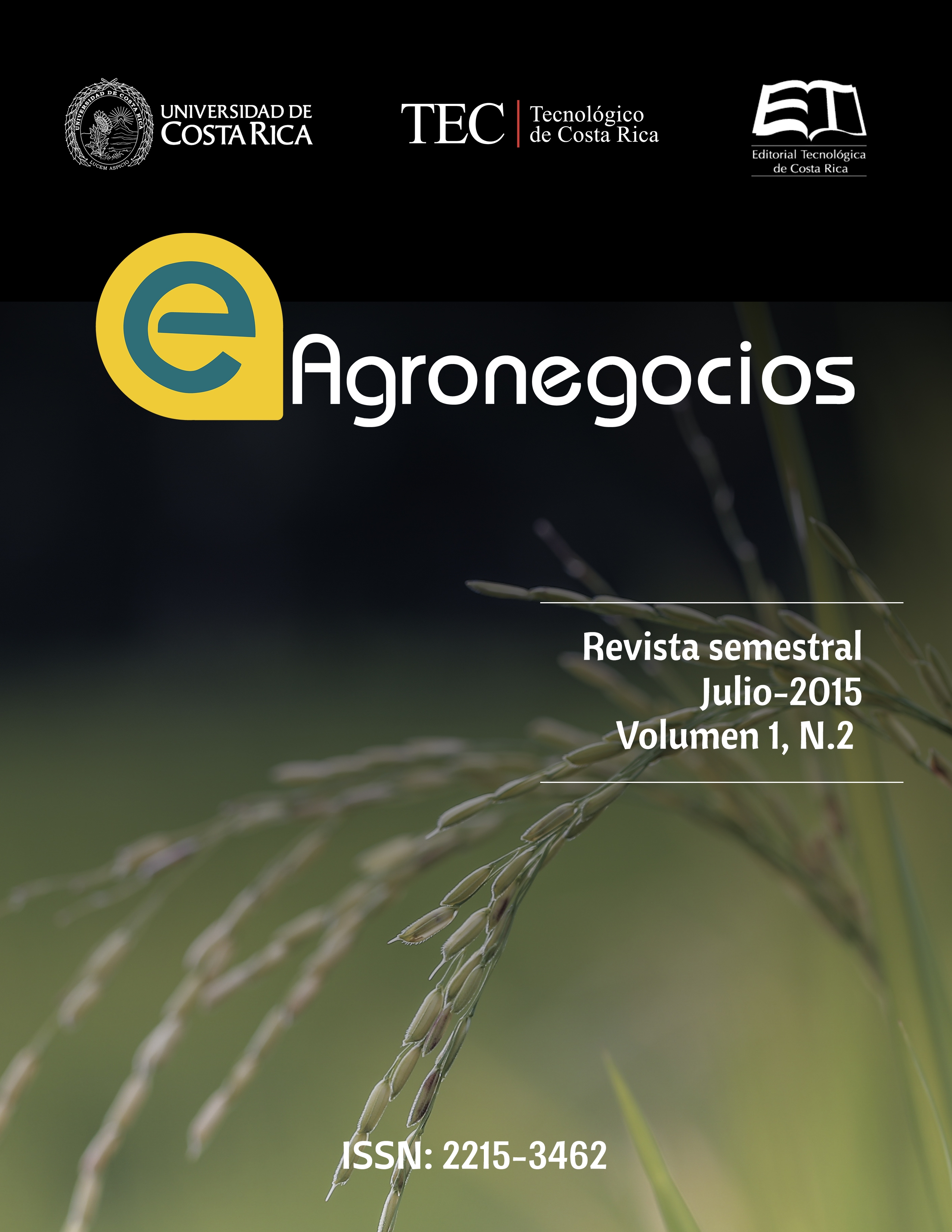Obtaining and economic index for banana producers of Indian Reserve Rey Curré
Main Article Content
Abstract
The main objective research is to produce a methodology in order to obtain one socioeconomics index for the Native Reserve platain-producing town of Rey Curré. The following indicators were taking into account: per capita monthly income, schooling, housing condition, family resources and access to health. Formerly, each indicator was weighted using the results of a panel of experts. Indicators like housing condition, family resources and access to health were subdivided each in variables, and then from a participatory panel (conformed by plantain producer) we obtained the importance of each variable within each indicator. Finally, a score is given to each variable for each producer and weighted with both, the weight given by the producers and the weight given by experts.
This generates a score from 0 to 100 for each producer. The index showed results for percapita income and schooling which fall below the national average indicators. Similarly a poor access to health was obtained; but on the other hand they own good quality houses.
Finally, regarding to family-productive resources, most of them own land and have access to irrigation water, however the lack of assets for irrigation and transport is a widespread problem. Putting all pieces together an average rate index of 45.6 (0-100), with low dispersion, is obtained
Article Details

This work is licensed under a Creative Commons Attribution-NonCommercial 4.0 International License.
Las personas autoras conservan los derechos de autor/a y ceden a la revista el derecho de la primera publicación y que pueda editarlo, reproducirlo, distribuirlo, exhibirlo y comunicarlo en el país y en el extranjero mediante medios impresos y electrónicos. Asimismo, las personas autoras asumen el compromiso sobre cualquier litigio o reclamación relacionada con derechos de propiedad intelectual, exonerando de responsabilidad a la Editorial Tecnológica de Costa Rica. Además, se establece que los autores pueden realizar otros acuerdos contractuales independientes y adicionales para la distribución no exclusiva de la versión del artículo publicado en esta revista (p. ej., incluirlo en un repositorio institucional o publicarlo en un libro) siempre que indiquen claramente que el trabajo se publicó por primera vez en esta revista.
References
Balestrieri, M. (2014). Rurality and Competitiveness. Some Observations on the Local Area: The Case of The Sardinian Region. International Journal of Rural Management, 173-197.
Banco Mundial. (2013). Conferencia Anual del Banco Mundial sobre Tierra y Pobreza. Grupo del Banco Mundial: El acceso a la tierra, esencial para los pobres.Washington: World Bank.
Besley, T., & Burgess, R. (2000). Land Reform, Poverty Reduction, and Growth: Evidence from India. The Quarterly Journal of Economics, 115(2), 389-430.
Bhupat, D., & Namboodiri, N. (1998). Policy Strategyr and Instruments for Alleviating Rural Poverty. Economic and Political Weekly, 33(41), 2669-2674.
Bonal, X. (2007). On global absences: Reflections on the failings in the education and poverty relationship in Latin America. International Journal of Educational Development, 27(1), 86-100.
Camargo, A., & Hurtado, A. (2011). Vivienda y pobreza: una relación compleja. CUADERNOS DE VIVIENDA Y URBANISMO, 224-246.
Chambers, R. (2006). What is poverty? Who asks? Poverty in focus 9: What is poverty?Concepts and Measures. Brasilia: International Poverty Center.
Commins, P. (2004). Poverty and Social Exclusion in Rural Areas: Characteristics, Processes and Research Issues. Sociologia Ruralis, 60-75.
Instituto Interamericano de derechos Humanos (IIDH). 2009. Campaña Educativa sobre Derechos Humanos y Derechos Indígenas: Modulo Medio ambiente y derechos indígenas desde la dimensión de la pobreza. San José. CR.
Instituto Nacional de Estadística y Censo (INEC) CR. 2012. Sistema de Consultas Censo de Población y Vivienda 2011. San José, CR.
Kay, C., & Gumá, M. (2007). Pobreza rural en América Latina: teorías y estrategias de desarrollo. Revista Mexicana de Sociología, 69(1), 69-108.
Mesalles L. y Céspedes O. 2009. Obstáculos al crecimiento económico de CR. San José CR.
Academia de Centroamérica. Consultado el 29/08/2012.
Montgomery, M., Stren, R., Cohen, B., & Reed, H. (2003). Diversity and inequality. En: Cities transformed: Demographic Chagen and its implications y the developing World. Londres: EARTHSCAN.
Müller S 1997. Evaluating the sustainability of agriculture.The case of the Reventado river watershed in Costa Rica.European University Studies Series V. Economics and
Pezzini, M. (2001). RURAL POLICY LESSONS. INTERNATIONAL REGIONAL SCIENCE REVIEW, 134-145.
Rodríguez V. Análisis de agrocadena y plan de negocios como herramientas para la competitividad: El caso de la agregación de valor para el plátano en el territorio indígena de Rey Curré, Puntarenas, CR. Tesis Lic en Economía Agrícola y Agroambiente. San José. CR. Universidad de Costa Rica.
Storti, D., & Henke, R. (2004). The New European Rural Policy: A Comparative Analysis across Regions in the EU. 87th EAAE Seminar ‘Assessing Rural Development Policies of the CAP’.

